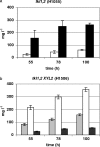Metabolic engineering of Saccharomyces cerevisiae for conversion of D-glucose to xylitol and other five-carbon sugars and sugar alcohols
- PMID: 17630301
- PMCID: PMC2042063
- DOI: 10.1128/AEM.02707-06
Metabolic engineering of Saccharomyces cerevisiae for conversion of D-glucose to xylitol and other five-carbon sugars and sugar alcohols
Abstract
Recombinant Saccharomyces cerevisiae strains that produce the sugar alcohols xylitol and ribitol and the pentose sugar D-ribose from D-glucose in a single fermentation step are described. A transketolase-deficient S. cerevisiae strain accumulated D-xylulose 5-phosphate intracellularly and released ribitol and pentose sugars (D-ribose, D-ribulose, and D-xylulose) into the growth medium. Expression of the xylitol dehydrogenase-encoding gene XYL2 of Pichia stipitis in the transketolase-deficient strain resulted in an 8.5-fold enhancement of the total amount of the excreted sugar alcohols ribitol and xylitol. The additional introduction of the 2-deoxy-glucose 6-phosphate phosphatase-encoding gene DOG1 into the transketolase-deficient strain expressing the XYL2 gene resulted in a further 1.6-fold increase in ribitol production. Finally, deletion of the endogenous xylulokinase-encoding gene XKS1 was necessary to increase the amount of xylitol to 50% of the 5-carbon sugar alcohols excreted.
Figures



Similar articles
-
Enhancing the flux of D-glucose to the pentose phosphate pathway in Saccharomyces cerevisiae for the production of D-ribose and ribitol.Appl Microbiol Biotechnol. 2010 Jan;85(3):731-9. doi: 10.1007/s00253-009-2184-4. Epub 2009 Aug 27. Appl Microbiol Biotechnol. 2010. PMID: 19711072
-
Effect of the reversal of coenzyme specificity by expression of mutated Pichia stipitis xylitol dehydrogenase in recombinant Saccharomyces cerevisiae.Lett Appl Microbiol. 2007 Aug;45(2):184-9. doi: 10.1111/j.1472-765X.2007.02165.x. Lett Appl Microbiol. 2007. PMID: 17651216
-
Feasibility of xylose fermentation by engineered Saccharomyces cerevisiae overexpressing endogenous aldose reductase (GRE3), xylitol dehydrogenase (XYL2), and xylulokinase (XYL3) from Scheffersomyces stipitis.FEMS Yeast Res. 2013 May;13(3):312-21. doi: 10.1111/1567-1364.12036. Epub 2013 Mar 4. FEMS Yeast Res. 2013. PMID: 23398717
-
A rare sugar xylitol. Part II: biotechnological production and future applications of xylitol.Appl Microbiol Biotechnol. 2007 Feb;74(2):273-6. doi: 10.1007/s00253-006-0760-4. Epub 2007 Jan 11. Appl Microbiol Biotechnol. 2007. PMID: 17216458 Review.
-
Advances in applications, metabolism, and biotechnological production of L-xylulose.Appl Microbiol Biotechnol. 2016 Jan;100(2):535-40. doi: 10.1007/s00253-015-7087-y. Epub 2015 Nov 3. Appl Microbiol Biotechnol. 2016. PMID: 26526452 Review.
Cited by
-
Progress in metabolic engineering of Saccharomyces cerevisiae.Microbiol Mol Biol Rev. 2008 Sep;72(3):379-412. doi: 10.1128/MMBR.00025-07. Microbiol Mol Biol Rev. 2008. PMID: 18772282 Free PMC article. Review.
-
Rewiring of Metabolic Network in Mycobacterium tuberculosis During Adaptation to Different Stresses.Front Microbiol. 2019 Oct 29;10:2417. doi: 10.3389/fmicb.2019.02417. eCollection 2019. Front Microbiol. 2019. PMID: 31736886 Free PMC article.
-
Statistics-based model for prediction of chemical biosynthesis yield from Saccharomyces cerevisiae.Microb Cell Fact. 2011 Jun 21;10:45. doi: 10.1186/1475-2859-10-45. Microb Cell Fact. 2011. PMID: 21689458 Free PMC article.
-
Production of bio-xylitol from D-xylose by an engineered Pichia pastoris expressing a recombinant xylose reductase did not require any auxiliary substrate as electron donor.Microb Cell Fact. 2021 Feb 22;20(1):50. doi: 10.1186/s12934-021-01534-1. Microb Cell Fact. 2021. PMID: 33618706 Free PMC article.
-
Stepwise metabolic adaption from pure metabolization to balanced anaerobic growth on xylose explored for recombinant Saccharomyces cerevisiae.Microb Cell Fact. 2014 Mar 8;13(1):37. doi: 10.1186/1475-2859-13-37. Microb Cell Fact. 2014. PMID: 24606998 Free PMC article.
References
-
- Aoki, M. A. Y., Y. G. Pastore, and K. Park. 1993. Microbial transformation of sucrose and glucose to erythritol. Biotechnol. Lett. 15:383-388.
-
- Bencini, D. A., J. R. Wild, and G. A. O'Donovan. 1983. Linear one-step assay for the determination of orthophosphate. Anal. Biochem. 132:254-258. - PubMed
-
- Blakley, E. R., and J. F. T. Spencer. 1962. Studies on the formation of d-arabitol by osmophilic yeasts. Can. J. Biochem. Physiol. 40:1737-1748. - PubMed
-
- de Wulf, P., W. Soetaert, D. Schwengers, and E. J. Vandamme. 1996. Screening and mutational improvement of a d-ribose secreting Candida pelliculosa strain. J. Ferment. Bioeng. 82:1-7.
-
- de Wulf, P., and E. J. Vandamme. 1997. Microbial synthesis of d-ribose: metabolic deregulation and fermentation process. Adv. Appl. Microbiol. 44:167-214.
Publication types
MeSH terms
Substances
LinkOut - more resources
Full Text Sources
Other Literature Sources
Molecular Biology Databases

